4 Drought-Tolerant Flowering Shrubs for Southern Gardens
Updated: Jan. 12, 2022
If you think drought tolerant means boring, try drought-tolerant flowering shrubs you'll want in the garden even when rainfall is plentiful.
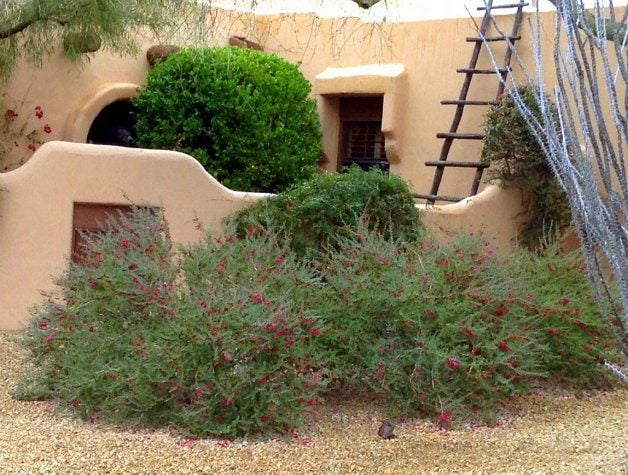
What does the term drought tolerant bring to mind? Perhaps a barren landscape covered in rock with a spiky cactus or two? Well it’s hard to call today’s drought tolerant garden barren—not with all of the beautiful, drought-tolerant plants available.
As a California native and now a resident of Arizona, drought-tolerant gardening is something that has been a part of my life for a very long time and has become second nature. However, that doesn’t mean that my garden is filled with cacti. Rather, my garden is filled with a lot of colorful plants that happen to be drought tolerant.
Today, I’d like to share with you some of my favorite drought-tolerant flowering shrubs, which are native to Australia. Many drought tolerant plants grown in the United States, come from Australia where most of the country is covered by large, arid areas that receive little rainfall. While all of the following shrubs can be grown outdoors in zones 8 to 11, those that live in cooler climates can grow them outdoors in containers and bring them inside where they can overwinter by a sunny window.
Psst—never plant these invasive shrubs (and what to grow instead!)
Valentine
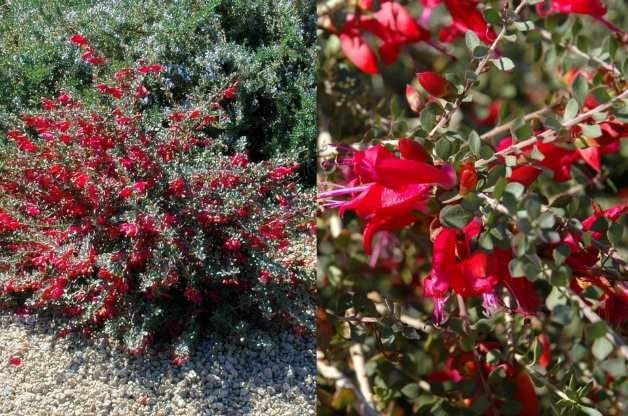
If you ask me what my favorite shrub is, I would unhesitatingly say Valentine bush. Fourteen years ago, I was approached by a wholesale nursery who was growing these red beauties. They gave me three shrubs and asked me to grow them in the landscape areas where I worked as a horticulturist. The rest as they say, is history. This shrub grew beautifully, had evergreen foliage that turned maroon in winter and starting in January, started producing vibrant red blooms that lasted until April.
A shrub that flowers in winter, looks great all year and is drought tolerant, is definitely worth considering. In cooler climates, the flowering can be delayed until late winter/early spring. When not in flower, Valentine bush continues to look great and requires pruning only once a year in late spring, after flowering had ceased. It grows approximately 3 ft. tall and 3 to 4 ft. wide. Hardy to 15 degrees (zone 8), its requirements are minimal. Plant in well-drained soil in an area that receives full sun. I have several Valentine shrubs growing in my garden and often include it in landscapes that I design.
Blue Bells
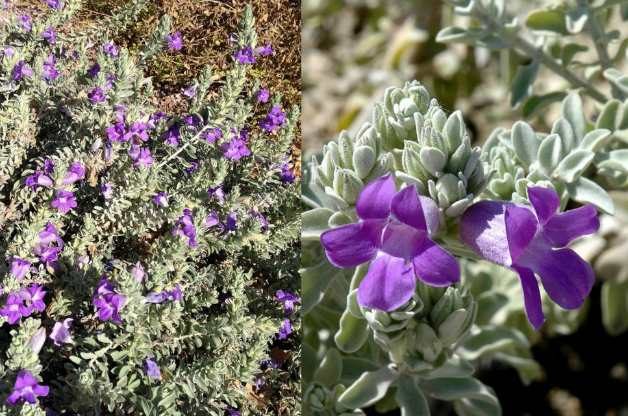
If you look closely at the leaves and flowers of Blue Bells, you’ll notice that they are covered with tiny hairs, which help them to handle hot, dry conditions by reflecting the sun’s rays. The gray foliage also offers another benefit to the landscape—its color contrasts beautifully with the darker green foliage of other plants in the landscape. Blue Bells is a small shrub that reaches 2 to 3 feet tall and 3 feet wide and seldom needs pruning. It’s rather small size makes it the perfect plant for planting in front of taller shrubs.
Blue Bells is a newer plant introduction that resembles Texas sage (Leucophyllum species), but is native to Australia. Hardy to 17 degrees (zone 8 and up), it will flower off and on throughout the year with the heaviest flush of flowering occurring in spring. The only problem with Blue Bells is that it struggles to survive in heavy, clay soils or those that do not drain well. However, when planted in well-drained soil and in full sun, this purple beauty will thrive. I confess, that I do not have any Blue Bells growing in my garden yet. I do use it often in landscape designs—especially in areas that receive hot, reflected sun. Follow these tips to conserve water in the garden.
Pink Beauty
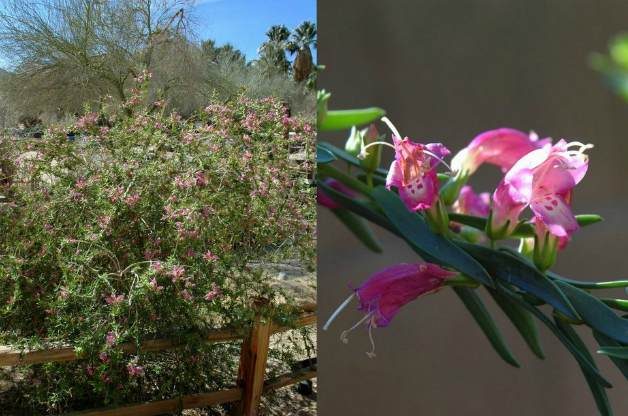
If you want birds to visit your garden, you may want to consider adding Pink Beauty. The large size and pink flowers will add beauty to your outdoor space while providing food and shelter for your feathered visitors. This pink flowering shrub has a rather untamed look. It is best used against a fence or corner where it can grow to its approximate size of 5 to 8 ft. tall and wide. Tubular pink flowers appear in spring and summer. Although I have also seen them appear in winter in zone 9.
Small birds are frequent visitors who seek shelter within its interior and feed upon the tiny insects that visit the flowers. Hummingbirds also find the flowers irresistible. This species of Eremophila can handle heavier, clay soils better than Valentine or Blue Bells. So, whether you plant it in clay or sandy soils, as long as it gets full to filtered sun it should thrive. Hardy to zones 8 and above, these shrubs, like the others, can be grown in a large container and brought inside to overwinter by a sunny window in colder zones. I have a single Pink Beauty shrub in my garden where it grows up against my fence. I can see it from my kitchen window and I enjoy seeing all of the birds who like to visit.
Summertime Blue
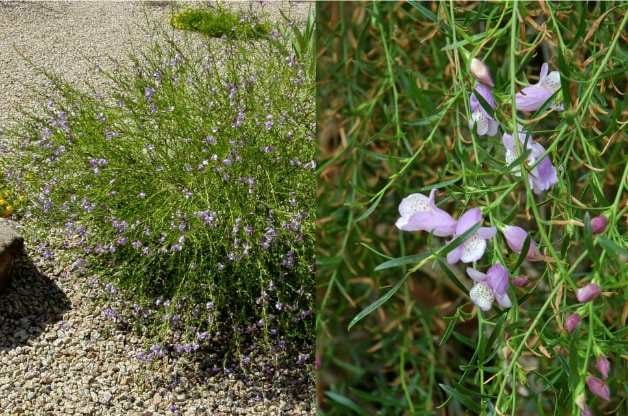
Narrow, bright green leaves set this species of Eremophila apart from the others. Named for its lilac-colored flowers that appear in summer and fall, Summertime Blue can grow to become a very large shrub, 6 ft. tall and 8 ft. wide. Its bright green foliage adds a visually cooling element to the drought tolerant landscape. While its long bloom season ensures the presence of colorful flowers. The interior of the flowers are spotted, which add to the beauty of this plant. The foliage of this shrub has a cascading growth habit, which needs little to no pruning, if allowed enough room to grow.
This evergreen shrub can be grown outdoors in zones 8 and above. In colder climates, bring them indoors in winter. Summertime Blue is not picky about soil, but does best in areas where they get full sun. I have two Summertime Blue shrubs in my garden that are five years old. I have not had to prune them once. They have plenty of room to grow and are truly a fuss-free plant that adds a lot of beauty to my drought tolerant garden.
Shrub Watering Tips
While these drought-tolerant flowering shrubs can handle varying periods without supplemental water, they do need some water in order to survive—especially when during the first year after planting. They can usually survive when watered deeply to a depth of 1 1/2 feet twice a month, during the summer months when rainfall is absent. Water slightly less in spring and fall and once a month in winter. Providing more supplemental water will increase the rate of growth. When grown in containers, they will need to be watered more frequently. Learn the best time to water plants.
Many local nurseries are beginning to stock drought tolerant, Australian native plants—particularly if you live in the southern half of the United States. Psst—these are the best places to buy plants and seeds online. For those of you who live in more temperate areas (zone 7 and below), here are more drought tolerant shrubs that you can grow outdoors all year long.